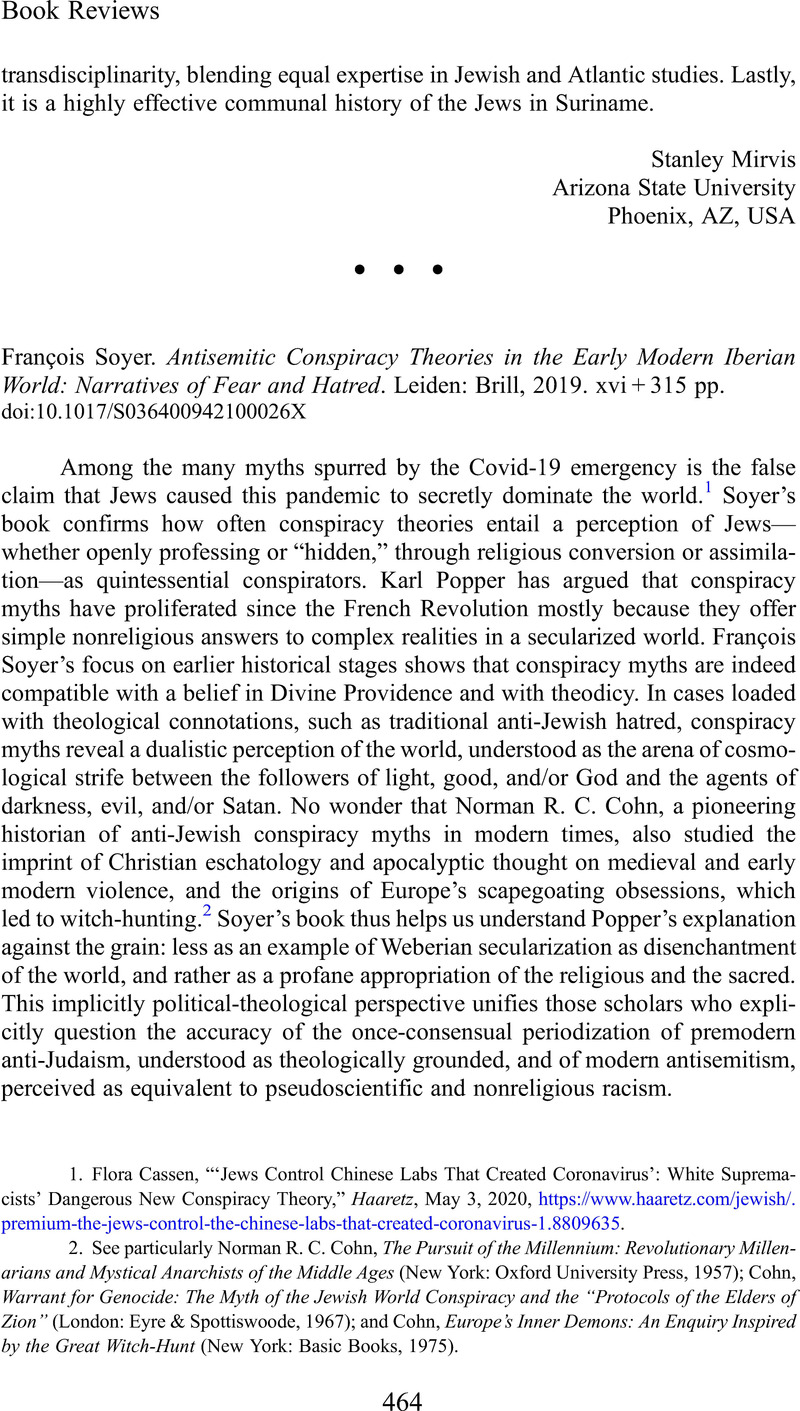No CrossRef data available.
Article contents
François Soyer. Antisemitic Conspiracy Theories in the Early Modern Iberian World: Narratives of Fear and Hatred. Leiden: Brill, 2019. xvi + 315 pp.
Review products
Published online by Cambridge University Press: 08 November 2021
Abstract

- Type
- Book Reviews: Medieval and Early Modern Eras
- Information
- Copyright
- Copyright © Association for Jewish Studies 2021
References
1. Flora Cassen, “‘Jews Control Chinese Labs That Created Coronavirus’: White Supremacists' Dangerous New Conspiracy Theory,” Haaretz, May 3, 2020, https://www.haaretz.com/jewish/.premium-the-jews-control-the-chinese-labs-that-created-coronavirus-1.8809635.
2. See particularly Cohn, Norman R. C., The Pursuit of the Millennium: Revolutionary Millenarians and Mystical Anarchists of the Middle Ages (New York: Oxford University Press, 1957)Google Scholar; Cohn, Warrant for Genocide: The Myth of the Jewish World Conspiracy and the “Protocols of the Elders of Zion” (London: Eyre & Spottiswoode, 1967); and Cohn, Europe's Inner Demons: An Enquiry Inspired by the Great Witch-Hunt (New York: Basic Books, 1975).
3. Roth, Cecil, “Marranos and Racial Antisemitism: A Study in Parallels,” Jewish Social Studies 2 (1940): 239–48Google Scholar; Yerushalmi, Yosef Hayim, “Assimilation and Racial Anti-Semitism: The Iberian and the German Models,” in Leo Baeck Memorial Lecture n. 26 (New York: Leo Baeck Institute, 1982)Google Scholar; Nirenberg, David, “Was There Race before Modernity? The Example of ‘Jewish’ Blood in Late Medieval Spain,” in The Origins of Racism in the West, ed. Eliav-Feldon, Miriam, Isaac, Benjamin, and Ziegler, Joseph (Cambridge: Cambridge University Press, 2009), 232–64Google Scholar.
4. Van Praag, Jonas Andries, “Los Protocolos de los Sabios de Sión y laIsla de los Monopantos de Quevedo,” Bulletin hispanique 51–52 (1949): 169–73CrossRefGoogle Scholar.
5. “I am not so sure, my Lord, that the Jews of Constantinople gave this advice to those of Spain, as that the Jews of Spain have implemented it.” Quevedo, Francisco de, Execración contra los judíos, ed. Cabo, Fernando Aseguinolaza and Santiago Fernández Mosquera (Barcelona: Crítica, 1996), 11Google Scholar.
6. Feitler, Bruno, The Imaginary Synagogue: Anti-Jewish Literature in the Portuguese Early Modern World (16th–18th Centuries) (Leiden: Brill, 2015)Google Scholar.
7. Soyer, François, Popularizing Anti-Semitism in Early Modern Spain and Its Empire: Francisco de Torrejoncillo and the Centinela contra Judíos (1674) (Leiden: Brill, 2014)CrossRefGoogle Scholar.
8. Griffin, Eric J., English Renaissance Drama and the Specter of Spain: Ethnopoetics and Empire (Philadelphia: University of Philadelphia Press, 2009), 113–20CrossRefGoogle Scholar.
9. Schwartz, Stuart B., All Can Be Saved: Religious Tolerance and Salvation in the Iberian Atlantic World (New York: Yale University Press, 2008)Google Scholar.
10. Yerushalmi, Yosef Hayim, From Spanish Court to Italian Ghetto: Isaac Cardoso: A Study in Seventeenth-Century Marranism and Jewish Apologetics (Seattle: University of Washington Press, 1981), 122–33Google Scholar, 151–64.





